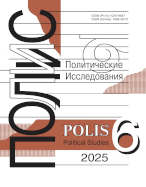Approaches to the Typology of European Small Countries (Case of Estonia, Latvia, Lithuania)
Zverev Yu.M.,
Associate Professor of Geography, Nature management and Spatial Development, I. Kant Baltic Federal University, Yzverev@kantina.ru
elibrary_id: 77644 |
Mezhevich N.M.,
Doctor of Economics, Professor, Department of European Studies, St. Petersburg State University; President of the Russian Association of Baltic Studies, mez13@mail.ru
elibrary_id: 210084 |
DOI: 10.17976/jpps/2019.05.13
Zverev Yu.M., Mezhevich N.M. Approaches to the Typology of European Small Countries (Case of Estonia, Latvia, Lithuania). – Polis. Political Studies. 2019. No. 5. https://doi.org/10.17976/jpps/2019.05.13
The study was performed at the Immanuel Kant Baltic Federal University with the financial support of the Russian Science Foundation (Project No. 18-17-00112 “Ensuring the Economic Security of the Regions of the Western Frontier of Russia in the Conditions of Geopolitical Turbulence”).
Although established political scientists have been developing the statehood typology for a long time, this task has not yet been completely solved. While considering this problem, the authors used various methods of comparative studies. The paper solves two main research problems. The first was to identify the key characteristics of small European countries in terms of modern global, regional, political, and economic processes. In the framework of this task, the main directions for identifying small countries were considered using both quantitative and qualitative indicators. The second task was to show the similarities and differences between small countries and limitrophes (border states). In the course of the analysis, the authors prove that all limitrophes are small countries, but not all small countries are limitrophes. In contrast to merely being a ‘small country,’ a limitrophe is a political category, rather than economic or geographical. This, however, does not contradict the geographical or economic characteristic features of limitrophes. It was from these theoretical and methodological positions that Vadim Tsymbursky, the prominent political scientist, analyzed the problem. The problem of limitrophes is interdisciplinary. However, it is the methodological apparatus of political science that, to the authors, seemed to be optimal for disclosing the content of this scientific category. If a small state, from a political point of view, is an intermediate space between states or military and political alliances, and a limitrophe is a barrier, a ‘cordon sanitaire’ separating them. The authors consider the Baltic States (Lithuania, Latvia, and Estonia) to be the benchmark example of limitrophe states.
References
Chambers R. 2004. Ideas for development: reflecting forwards. – IDS Working Paper 238. URL: http://opendocs.ids.ac.uk/opendocs/bitstream/handle/123456789/669/Wp238.pdf?sequence=1 (accessed 15.07.2019).
Economic Consequences of the Size of Nations. 1960. Ed. by E. Robinson. New York: St. Martin’s Press.
Gerschenkron A. 1962. The Approach to European Industrialization: a Postscript. – Economic Backwardness in Historical Perspective. Cambridge, MA: Harvard University Press. P. 353-364.
Henrikson A.K. 2001. A Coming ‘Magnesian’ age? Small States, the Global System, and the International Community. – Geopolitics. No. 6. P. 62-63. https://doi.org/10.1080/14650040108407729
Keohane R. 1969. Lilliputians’ Dilemmas: Small States in International Politic. – International Organization. Vol. 23. No. 2. P. 291-310. https://doi.org/10.1017/S002081830003160X
Laurinavicius C., Motieka E., Statkus N. 2005. Baltijos valstybiu geopolitikos bruozai. XX amzius. Vilnius: LII leidykla.
Rothstein R.L. 1968. Alliances and Small Powers. New York: Columbia University Press. https://doi.org/10.1086/ahr/74.5.1614
Busygina I.M., Klimovich S.A. 2017. A Coalition within a Coalition: the Baltics in the European Union. – Baltiiskii region. Vol. 9. No 1. P. 7-26. (In Russ.) https://doi.org/10.5922/2074-9848-2017-1-1
Gessen S.Ya. 1926. Okrainnye gosudarstva: Pol’sha, Finlyandiya, Estoniya, Latviya i Litva [Outlying States: Poland, Finland, Estonia, Latvia and Lithuania]. Leningrad: Priboi.
Il’inskij I.D. 1925. Gosudarstva zapadnogo rubezha [Western Frontier States]. Leningrad: Gosizdat. (In Russ.)
Komleva N.A. 2015. War in the Border States: Evolution of Technology. – Prostranstvo i vremya. No. 1-2. P. 32-42. (In Russ.) URL: https://space-time.ru/space-time/article/view/2226-7271provr_ st1_2-19_20.2015.13/11 (accessed 15.07.2019).
Kuper R. 2010. Razdor mezhdu narodami. Poryadok i khaos v XXI veke [Discord among Nations. Order and Chaos in the Twenty-First Century]. Moscow: Moskovskaya shkola politicheskikh issledovanii. (In Russ.)
Lietuvis. 1918. S Germaniej ili s Rossiej? Blizhajshie sud’by Pol’shi, Ukrainy, Finlyandii, Litvy, Belorussii, Estonii, Latvii, Kavkaza, Kryma [Germany or Russia? Nearest fate of Poland, Ukraine, Finland, Lithuania, Belarus, Estonia, Latvia, Caucasus, Crimea]. Petrograd – Moscow.
Maksimtsev I. A., Mezhevich N. M., Koroleva A.V. 2017. Economic Development of the Baltics and Nordic Countries: Characteristics of Economic Models. – Baltiiskii region. T. 9. No. 1. P. 60-78. (In Russ.) https://doi.org/10.5922/2074-9848-2017-1-4
Poltavskij M.A. 1973. Diplomatiya imperializma i malye strany Evropy (1938-1945 gg.) [Diplomacy of Imperialism and the Small Countries of Europe (1938-1945)]. Moscow: IVI RAN.
Skriba A. 2014. The Balancing of Small and Medium-Sized Nations. – International Trends. Vol. 12. No. 4. P. 88-100. (In Russ.) URL: http://intertrends.ru/old/thirty-ninth/Skriba.pdf (accessed 15.07.2019).
Smirnov V.A. 2014. The Role of Small Countries in Post-Soviet Territorial Restructuring: The Baltic Case]. – Baltjiskij region. No. 4 (22). P. 48-58. (In Russ.) https://doi.org/10.5922/2074-9848-2014-4-3
Smirnov V.A. 2016. Foreign Policy of Baltic States towards Russia. – Sovremennaya Evropa. No. 5. Р. 44-54. (In Russ.) http://dx.doi.org/10.15211/soveurope520164146
Smirnov V.A. 2017. The Relations of the Political Elite of the Baltic States. – Political Expertise Journal. Vol. 13. No. 1. P. 93-102. (In Russ.)
Tzymbursky V.L. 1993. Routes of Liberalism in Russia. – Polis. Political Studies. 1993. No. 1. P. 31-45. (In Russ.)
Tzymbursky V.L. Ideya suvereniteta v pozdnesovetskom i postsovetskom kontekste [The Idea of Sovereignty in the Late Soviet and Post-Soviet Context]. – Metodologicheskii seminar: “Problema politicheskogo suvereniteta: istoriya problemy i sovremennost’” [Methodological Seminar: “The Problem of Political Sovereignty: the History of the Problem and Modernity” (headed by I.K. Pantin)]. Moscow: IF RAS. (In Russ.) URL: https://iphras.ru/uplfile/histpol/seminar/zymbursky.doc (accessed 15.07.2019).
Tzymbursky V.L. 2007. Zemlya za Velikim Limitrofom: ot “Rossii-Evrazii” k “Rossii v Evrazii” [The Land beyond the Great Limitrophe: from the “Russia-Eurasia” to “Russia in Eurasia”]. – Tzymburskii V.L. Ostrov Rossiya: Geopoliticheskie i hronopoliticheskie raboty. 1993-2006. [Island Russia: Geopolitical and Chronopolitical Works. 1993-2006]. Moscow: ROSSPEN.
Vainu Kh. 1990. Estoniya: uzel mezhnatsional’nykh protivorechii [Estonia: the Site of Ethnic Conflicts]. Tallin: Olion. (In Russ.)
Vodovozov V.V. 1925. Novaya Evropa [New Europe]. Praha: Plamya. (In Russ.)
Vorotnikov V.V. 2014. Baltic States in NATO: Results of the Decade. – MGIMO Review of International Relations. No. 6. P. 9-17. (In Russ.) URL: https://vestnik.mgimo.ru/jour/article/view/236/236 (accessed 15.07.2019)
See also:
Smirnov V.A.,
Theoretical and Methodological Aspects of Political Elites’ Institutionalization in the Baltic States. – Polis. Political Studies. 2017. No5
Musikhin G.I.,
Models of Modern Capitalism in New Political Economy: between Science and Ideology. – Polis. Political Studies. 2009. No3
Baev V.G., Marchenko A.N.,
In the footsteps of what we read: a small book on a big problem. – Polis. Political Studies. 2022. No1
Pantin V.I.,
Studying the prospects of international political developments: problems of a methodological synthesis. – Polis. Political Studies. 2012. No6
Melville A.Yu., Ilyin M.V., Meleshkina E.Yu., Mironyuk M.G., Sergeev V.M., Timofeev I.N.,
Political Atlas-2: World Crisis Megatrends. – Polis. Political Studies. 2009. No3




.jpg)






 print
print
.jpg)
.jpg)